Competitive Analysis – What is it and how to easily get started?
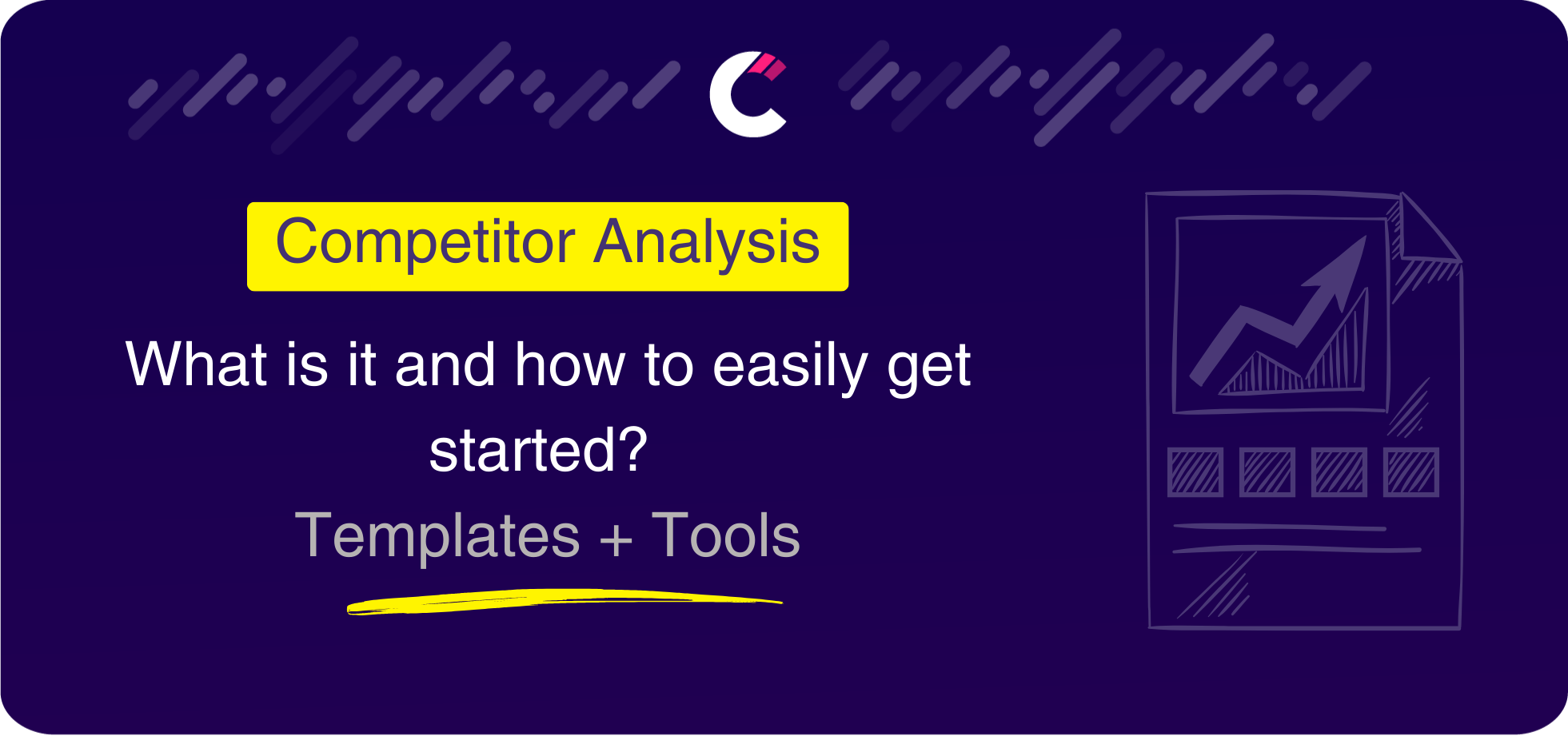
A few years ago, I started a small SaaS business in Europe. We launched a new product and watched it struggle to get any sales while a competitor’s similar product took off. But what made our competitor thrive? Frustrated, we dug deeper – analyzing pricing, marketing, and customer feedback.
After spending some time in competitive analysis, We found that the competitor had been investing heavily in PPC ads, had an affiliate program and relied on influencers to boost brand awareness. Within 4 months, We adopted our competitors’ best practices and saw a 40% increase in sales.
We weren’t alone. According to a study done by Small Biz Trends, 94% of businesses invest in competitive analysis to find out what their competitors are doing to succeed. But how do you do it effectively?
In the post, we’ll go through everything you need to do competitor analysis. starting with how to identify your competitors, the best techniques, tools to use and even ready-made templates that you can use!
What is Competitive Analysis?
Competitive analysis (AKA competitive research) in a nutshell, is about gathering info on how your competitors operate, what’s working for them and what’s not and understanding how you can bridge the gap.
It contains gathering insights about:
- Media Budget Allocation
- Competitors Ads
- Competitors Emails
- Competitors Pricing
- Competitors Customer Reviews
- Competitor Features
And more!
Want to find out why a competitor’s new product is doing better than yours? Want to find out how a new startup is quickly gaining more market share? Competitor Analysis is your answer!
What is Competitive Market Research?
When I started my first SaaS business, I thought I had everything figured out.
A great product, remarkable branding, and a well-designed website.
But I was so devastated when our sales were very slow, while at the same time, a competitor with a very identical product was selling like crazy!
It wasn’t about the product or about having better branding; they must have known something we didn’t.
I couldn’t just sit there and watch my competitor win while my brand barely made any profits.
I remember one day, I grabbed my notebook and sat down in front of my laptop. And I spent a good afternoon doing everything I could to figure out why they outperformed us. From checking out their ads, studying their prices, and even reading their customer reviews to see what people liked (or didn’t).
It didn’t take me long to know the difference, they weren’t just running ads randomly; they had an entire system in place. They knew exactly who to target, how to price their product, and which influencers to work with.
So, I tried to replicate some of their tactics. I set up PPC campaigns targeting their keywords, and reached out to influencers to help make my brand look more authentic.
Four months later? My sales jumped 40%, and I finally felt like I was in the game.
That’s why you can’t sleep on competitive market research! it is about collecting and analyzing data about your competitors, industry trends, and market shifts.
It’s not just about knowing who your competitors are but understanding what’s working for them, where the gaps are, and how you can strategically position yourself for success.
Studying things like pricing models, customer sentiment, marketing strategies, and operational tactics, businesses can uncover real opportunities to differentiate and scale.
It’s not about copying but rather about gaining a strategic advantage over the competition by spotting trends before they become mainstream and identifying market gaps competitors haven’t filled.
Competitive Analysis vs. Market Research
It’s easy to get confused and think that competitive analysis is the same as market research, but they actually serve different purposes.
Here’s how I break it down:
- Competitive Analysis is focused on rivals or competitors: what they’re doing, how they’re doing it, and where you can do better. It’s about tracking their pricing, marketing campaigns, reviews..etc to identify opportunities to stand out.
- Market Research is broader – it looks at the entire market trends, customer behavior, and external factors like economic shifts to help businesses make data-driven decisions beyond competition.
Here’s how they differ in a nutshell:
Aspect | Competitive Analysis | Market Research |
Focus | Direct and indirect competitors | The entire market, customer behavior, trends |
Objective | Find competitive advantages | Identify market opportunities and customer needs |
Data Sources | Competitor pricing, ads, reviews, strategies | Surveys, focus groups, industry reports |
Outcome | Insights for outperforming competitors | Guidance for market positioning and product development |
What is included in competitive analysis?
Back when I was a junior marketer, I made the most common competitor analysis mistake. : Only looking at the surface-level stuff such as ads, pricing, and social media engagment.
But as I got more experience, I realized that a real competitive analysis goes much deeper than this.
Whether you’re in SaaS, B2B, e-commerce, or any other industry, You need a good understanding of your competitors’ strategies, customer base, and business models to stay ahead.
Here’s what you should focus on when breaking down a competitor’s strategy:
1. Business & Company Metrics
Ever wondered why a competitor is suddenly everywhere – sponsoring events, running ads non-stop, or expanding aggressively? Their financials and growth metrics answer your question here.
Here are important metrics to check:
- Funding rounds & investors (via Crunchbase).
- Revenue estimates & employee growth (via LinkedIn).
- Pricing models (Do they use freemium? Enterprise plans?).
- Market share & profitability (via industry reports).
- Order volume & fulfillment speed (Are they using 3PLs?).
- Subscription models & retention rates (Are they locking in customers?).
Understanding the financials and growth metrics of your competitors gives you a very good idea of how big they’re.
2. Competitive Product Analysis
Comparing your competitors’ products to yours is essential if you want to gain an edge.
If it’s a digital product here’s what you should look at:
- Feature set – What functionalities do they offer that you don’t?
- Customer feedback – Check G2, Capterra, and Trustpilot to see what users love (or hate).
- Onboarding & UX – Sign up for their free trial. Is their onboarding smoother? Do they have better support?
If it’s a physical product here’s what you should look at:
- Product quality – Buy their product and compare it.
- Pricing strategy – Are they running discounts or bundling products?
- Packaging & branding – Are they using premium unboxing experiences?
You can learn a lot just by being a customer of your competitor.
3. Customers & Market Awareness
One thing I learned in my career? The best products don’t always win, but the ones with the strongest communities do.
That’s why you should always analyze:
- Who are their customers? (Startups? Enterprises? Agencies?)
- What’s their engagement like? (Do they have an active Slack or Facebook group?)
- Are they getting media attention? (Mentions in TechCrunch? PR strategies?)
- Social listening tools (Are influencers talking about them?)
- Review sentiment (What are common complaints?)
- Brand loyalty indicators (Are people buying repeatedly?).
Competitors who own their audience through strong customer relationships often dominate their niche even if they don’t have the best product.
4. Competitive Marketing Analysis
The biggest lesson I learned in growth marketing? Marketing isn’t just about spending more money, but rather about making the most out of your money.
Here’s what you should look at in your competitors’ marketing strategy:
- SEO & content strategy – What keywords are they ranking for? Do they have a blog or webinars?
- Outbound vs. inbound – Are they relying on cold emails, paid ads, or organic growth?
- Sales funnel – Do they use demos, free trials, or aggressive retargeting?
- Ad creative & platforms – Are they crushing it on Meta, TikTok, or Google Shopping?
- Email & SMS marketing – How often do they send promotions?
- Affiliate & influencer partnerships – Are they using ambassadors or discount codes?
Using tools like Ahrefs, SEMrush, and Competitors App, you can figure out exactly how competitors drive traffic and convert leads.
Why Perform a Competitive Analysis?
At first, when I was starting out, I didn’t think competitive analysis was that important. I figured if I just focused on building a great product and marketing it well, I’d be just fine. But then I saw competitors outmaneuvering me – launching features before I did, running better ads, and grabbing market share I thought I had locked down.
That’s when I realized: competitive analysis isn’t optional – it’s a must for survival.
It’s not about being obsessed with your competitors or copying them. But rather about understanding the landscape so you can position yourself strategically instead of making blind guesses.
When you know what’s working for others, where the gaps are, and how your competitors operate, you’re no longer just reacting – you’re making moves that actually give you an edge.
Let’s break down exactly why competitive analysis is a must do!

Benefits of Competitive Analysis for your company
1. Find Your Strengths and Weaknesses
I once thought my product was unique – until I saw a competitor offering the same thing with better features and a lower price. Competitive analysis helps you see your blind spots before they cost you customers.
- For SaaS & B2B: Maybe your onboarding sucks compared to competitors. Maybe your pricing isn’t attractive for mid-sized companies.
- For e-commerce & DTC: Maybe your competitors bundle products or offer better discounts, and that’s why they’re outselling you.
Knowing where you’re strong and where you need to improve is key to long-term growth.
2. Win More Deals & Customers
Businesses that conduct competitive analysis are 20% more likely to win competitive deals. Why? Because they’re prepared.
- If you’re in B2B SaaS, this means knowing exactly how to counter competitor objections in sales calls.
- If you’re in e-commerce, it means knowing when to adjust your pricing or run aggressive promotions to stay competitive.
- If you’re a startup, it means figuring out how to position yourself as the better alternative – without burning your budget.
The brands that win aren’t always the best – they’re the ones that understand the game better.
3. Nail Your Unique Selling Proposition (USP)
The first time I tried to explain what made my business different, it was vague. “We have great customer service” or “We offer high-quality products” – generic things that everyone says.
But after studying my competitors, I could clearly pinpoint my USP:
- For SaaS: “We offer faster setup than [competitor] and integrate with twice as many tools.”
- For e-commerce: “Unlike [competitor], we use 100% recycled materials and ship in two days.”
- For B2B services: “We’re the only agency that offers both SEO and paid media with a revenue-sharing model.”
Competitive analysis helps you find the gap that competitors aren’t filling – and own it.
4. Spot Industry Trends Before They Explode
I once dismissed TikTok ads because I thought they were just for Gen Z. A year later, my competitor was printing money while I struggled to catch up.
Trends start with early adopters – and if you’re watching your competitors closely, you can either:
- Be the first mover (and own the trend).
- Be a fast follower (and avoid missing the boat).
Either way, you’re not playing catch-up when it’s too late.
5. Set Realistic Growth Goals
I used to set random revenue goals without knowing if they were realistic. But when you analyze competitors, you can set benchmarks based on actual industry data.
- For SaaS startups: What’s a reasonable churn rate? How fast do similar companies grow?
- For e-commerce brands: What’s the industry standard for conversion rates and ad spend?
- For agencies & B2B services: How long does it actually take to close a deal in your niche?
Instead of guessing, competitive analysis gives you real numbers to measure against.

When and how often should you perform competitive analysis?
By now you could be thinking, “Okay, this sounds important, but how often should I do it?” – it depends on your industry.
- Fast-moving industries (tech, fashion, e-commerce): Monthly or even weekly if competition is fierce.
- B2B & SaaS: A quarterly deep dive is usually enough, with ongoing tracking for big changes.
- Local businesses & slower industries: Twice a year might be enough unless a new player enters your space.
The key? Don’t just do it once and forget about it. Markets shift, new competitors pop up, and customer preferences change. Make it a habit!
How do identify your competitors when doing Competitor Analysis?
One of the biggest mistakes I made early on? Having no idea who my competitors are.
Your competitors aren’t just the brands selling the same product as you, but rather those solving the same problem even if in a different way!
If you get this wrong, you’ll waste time tracking the wrong players, chasing bad strategies, and missing real opportunities. So, here’s how to identify your true competitors the right way.
1. Spot Your Direct & Indirect Competitors
Most people just focus on direct competitors or the businesses selling the same product or service.
While indirect competitors (those solving the same problem in a different way) can be just as dangerous.
Direct Competitors: Sell the same product or service as you.
Indirect Competitors: Sell something different but compete for the same audience.
Example:
- If you run a project management SaaS, your direct competitor might be Trello.
- But your indirect competitors? Slack (if teams use it instead of a PM tool) or even physical sticky notes and notebooks!
If you ignore indirect competitors, you might miss shifts in customer behavior that could hurt your business.
2. Use Google to See Who’s Ranking for Your Keywords
The easiest way to find competitors? Search like a customer.
- Go to Google and type in the keywords your audience would use.
- Look at the top results – the businesses showing up there are stealing your traffic and potential customers.
- Check the ads too – if a company is paying to show up for your keywords, they’re a competitor.
💡 Pro Tip: Use search operators like “best [your product] alternatives” to uncover even more competitors.
3. Check Industry Reports & Publications
Sometimes, competitors aren’t obvious until they start making big moves. That’s why you should always keep an eye on industry reports and publications.
- For SaaS & B2B: Read reports from places like Gartner, Forrester, or industry blogs to spot rising players.
- For e-commerce & DTC: Platforms like CB Insights or industry trend reports reveal market shifts before they hit mainstream.
This is how you spot up-and-coming competitors before they become a threat.
4. Listen to Your Customers – They’ll Tell You Who Your Competitors Are
This one took me a while to learn: Customers compare you to competitors way more than you think.
If someone says, “I was choosing between you and [Competitor X],” – that’s golden.
Where to find these insights?
Customer feedback & reviews – What brands do they mention when they talk about alternatives?
Sales calls & support tickets – Ask, “What other tools or solutions were you considering?”
Social media comments & Reddit threads – People discuss competitors openly here.
If customers see a competitor as an alternative to you, they should be on your radar.
5. Monitor Social Media & Online Communities
Want to keep tabs about your customers think of your competitors? Go where the conversations happen.
Platforms like: LinkedIn, Twitter, Reddit, Facebook Groups, Slack Communities – These are gold mines for spotting rising competitors and seeing what customers love (or hate) about them.
Here’s what I would do:
1️⃣ Search for your industry keywords + “alternative” or “competitor.”
2️⃣ Check competitor mentions in discussions and comments.
3️⃣ See what pain points people bring up about your competitors – you might find an opportunity.
This works especially well for SaaS, B2B, and service-based businesses.
6. Automate It with a Competitor Finder Tool
Finding competitors can be a very time-intensive task, which is why I recommend using a tool like our free competitor finder to automate the process and identify competitors in almost no time!
All you need is to input your website URL and a keyword and the tool we’ll get you a list of your competitors!
How to perform Competitor Analysis in 6 Steps

Step 1: Define Your Competitors
Use the Competitors App Competitor Finder to identify who you're up against in the market.
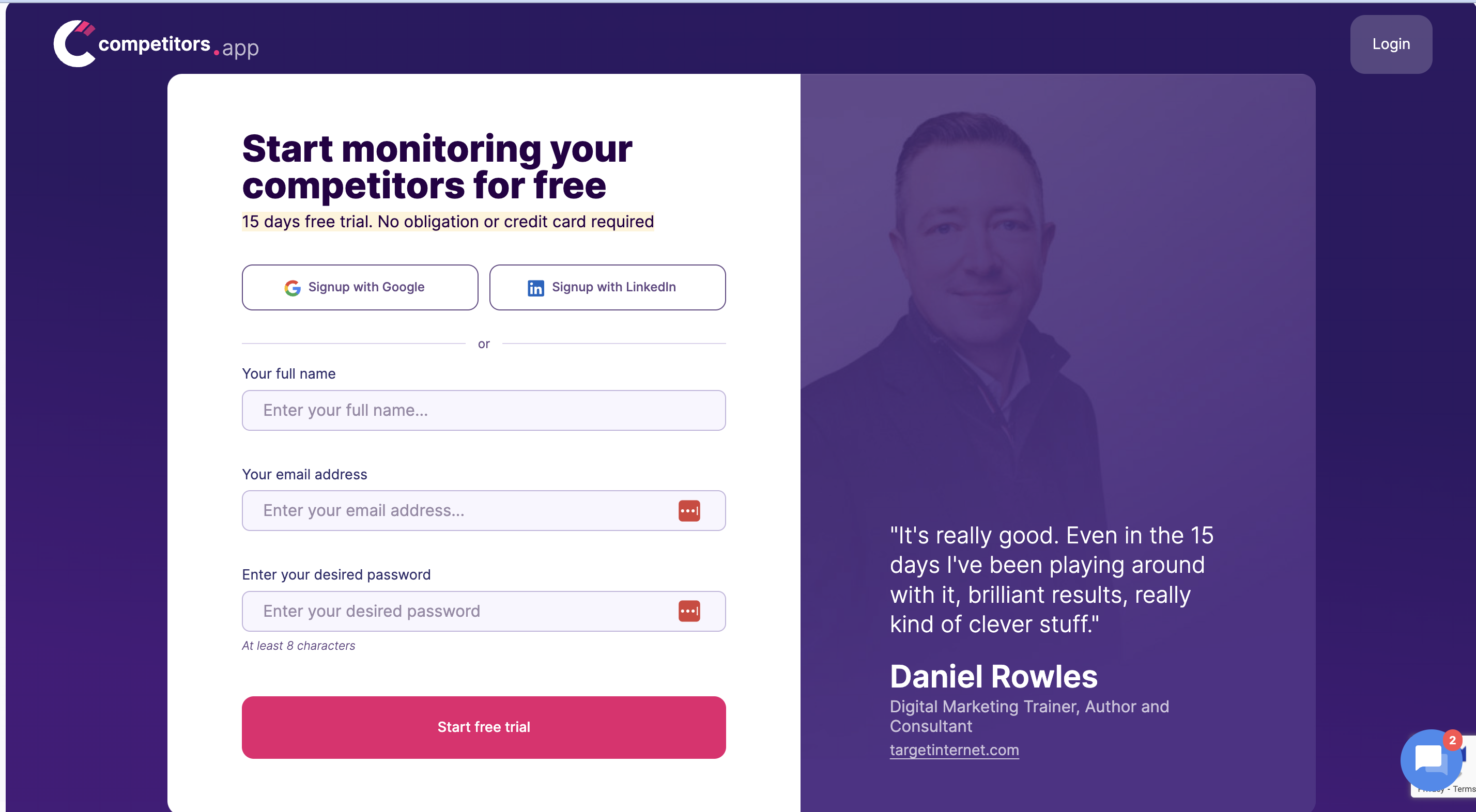
Step 2: Get Started with a Free Trial
Sign up for a Competitors App Free trial account to unlock a wealth of features designed to give you an edge.
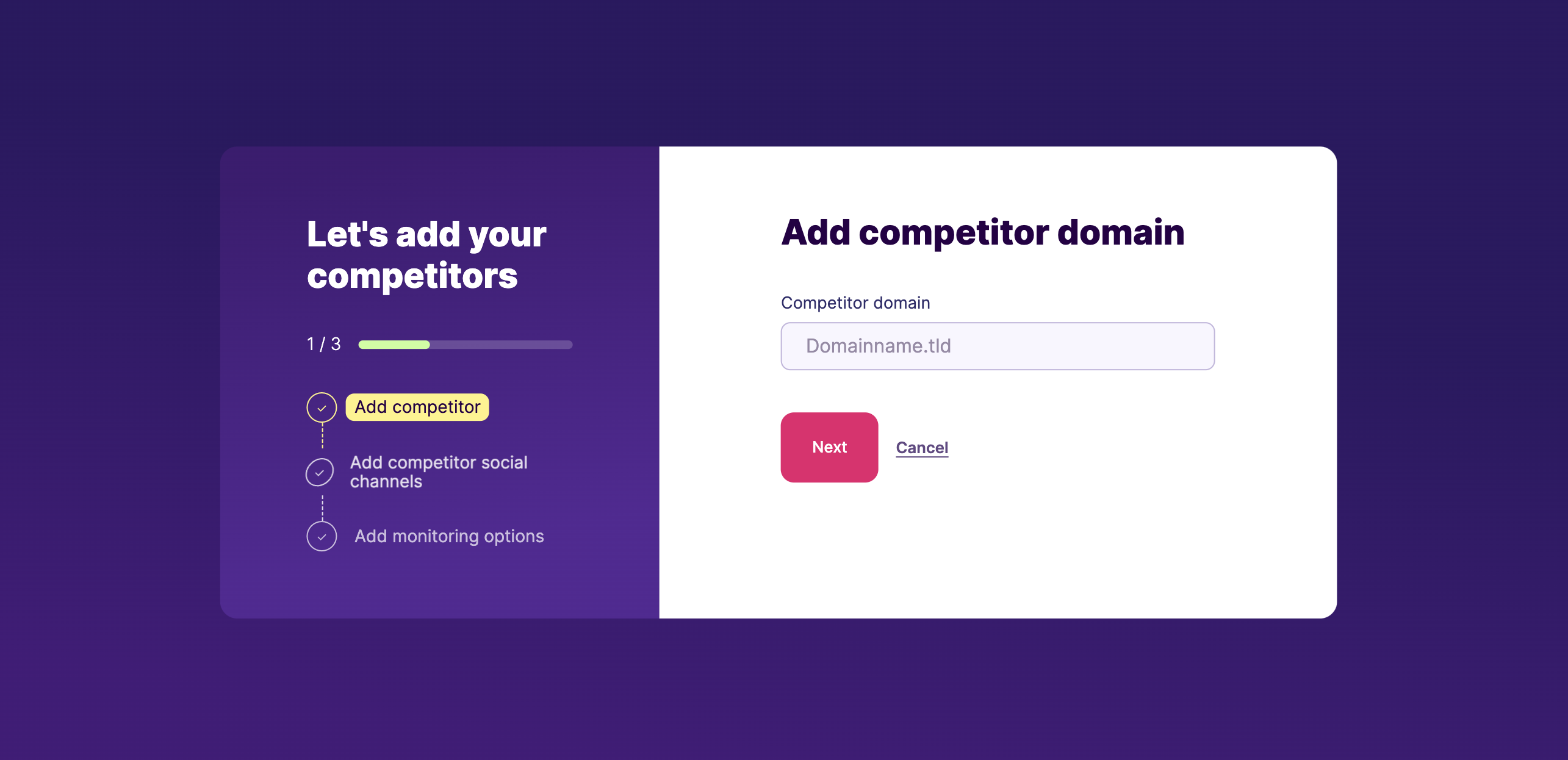
Step 3: Add Your Competitors
Add your competitor domain on the field. Competitors app will automatically detect their social media, most important website pages, and reviews
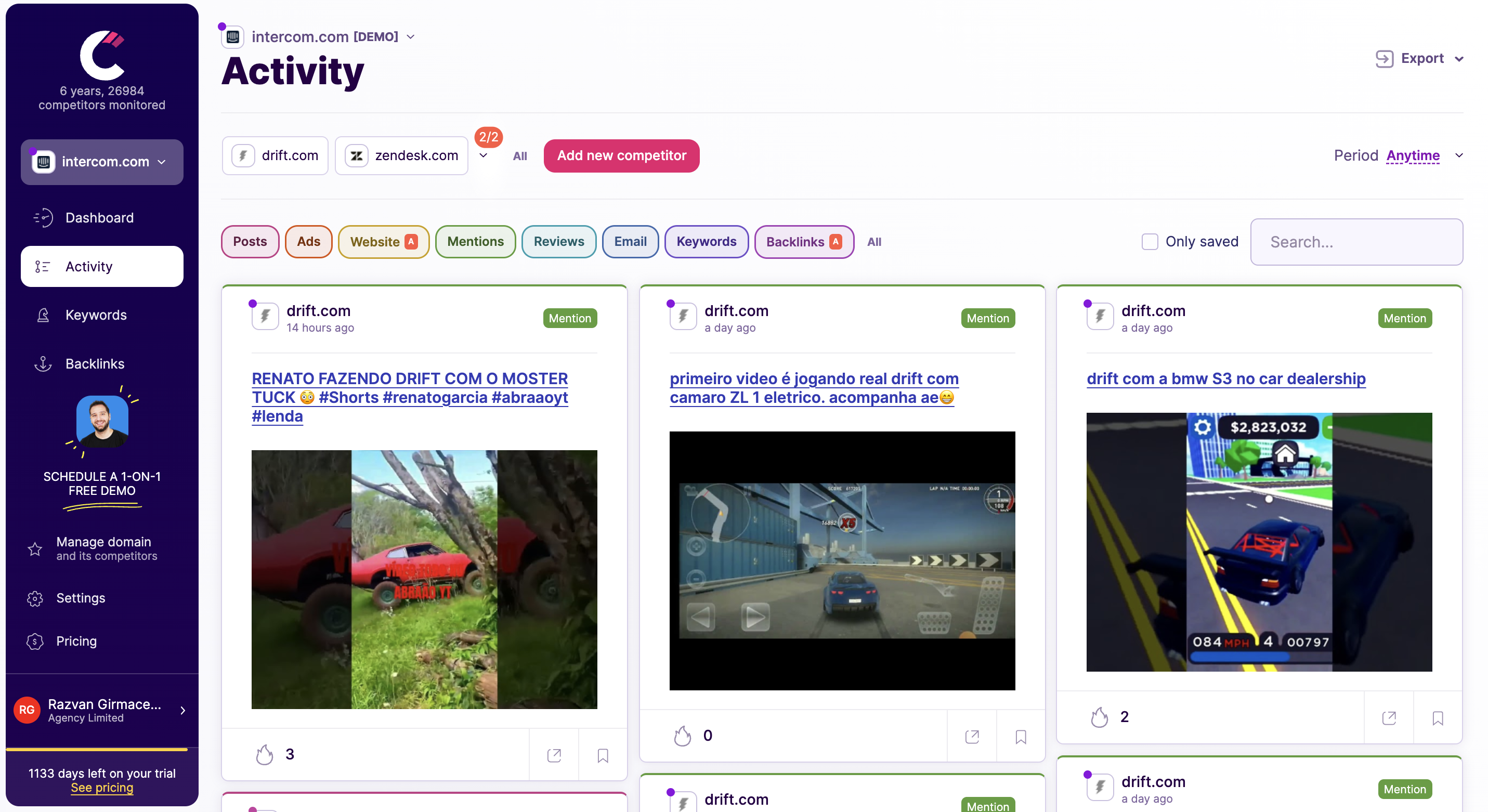
Step 4: Review New and Historical Activity
Start diving into the historical activity of your competitors. This will give you a clearer picture of their past strategies and performance metrics. At the same time keep an eye for new updates.
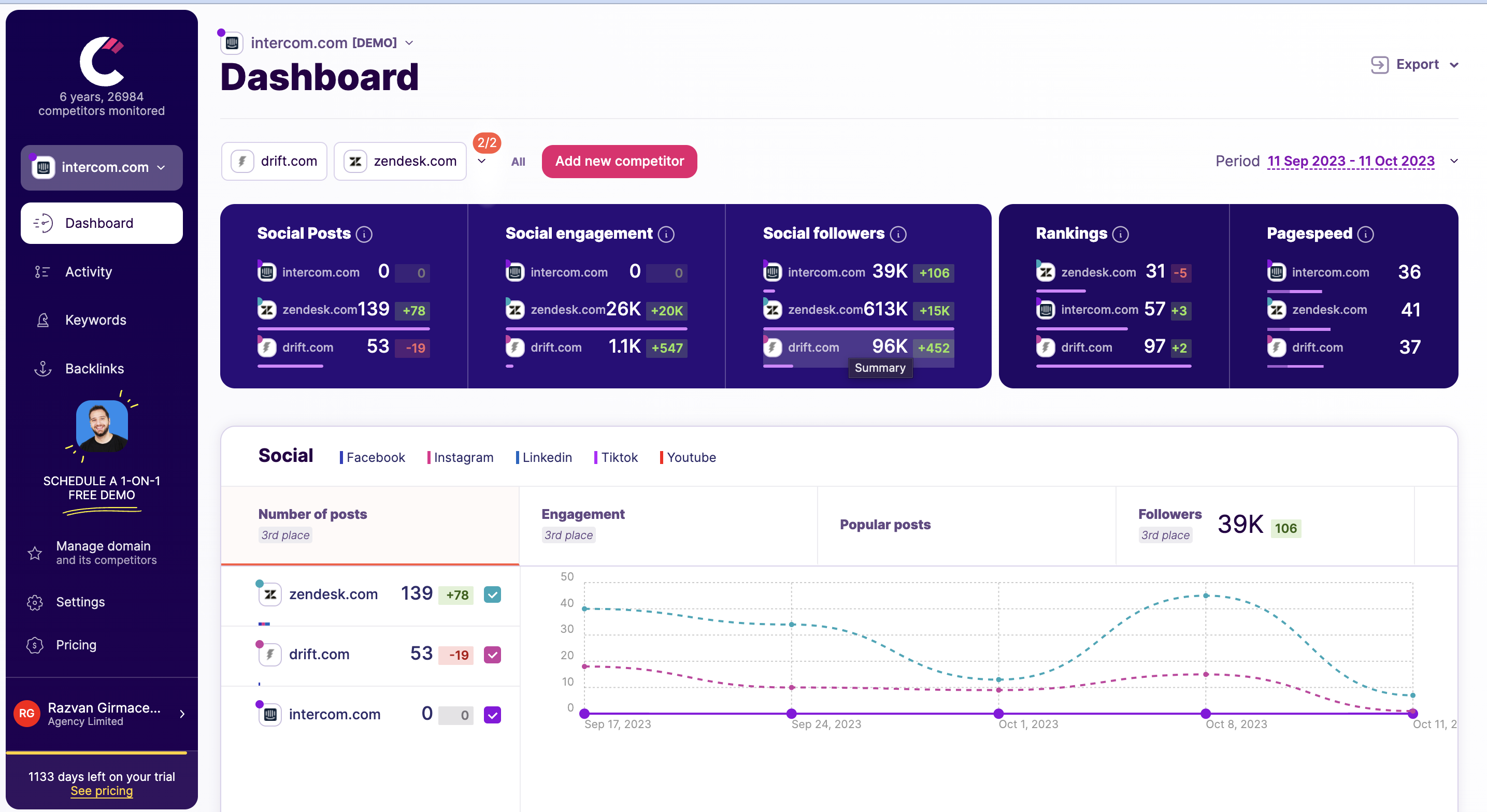
Step 5: Benchmark Yourself
Use Competitors App Dashboard and the data you've collected to benchmark your company against the competition. This will help you identify your strengths and weaknesses in the market.
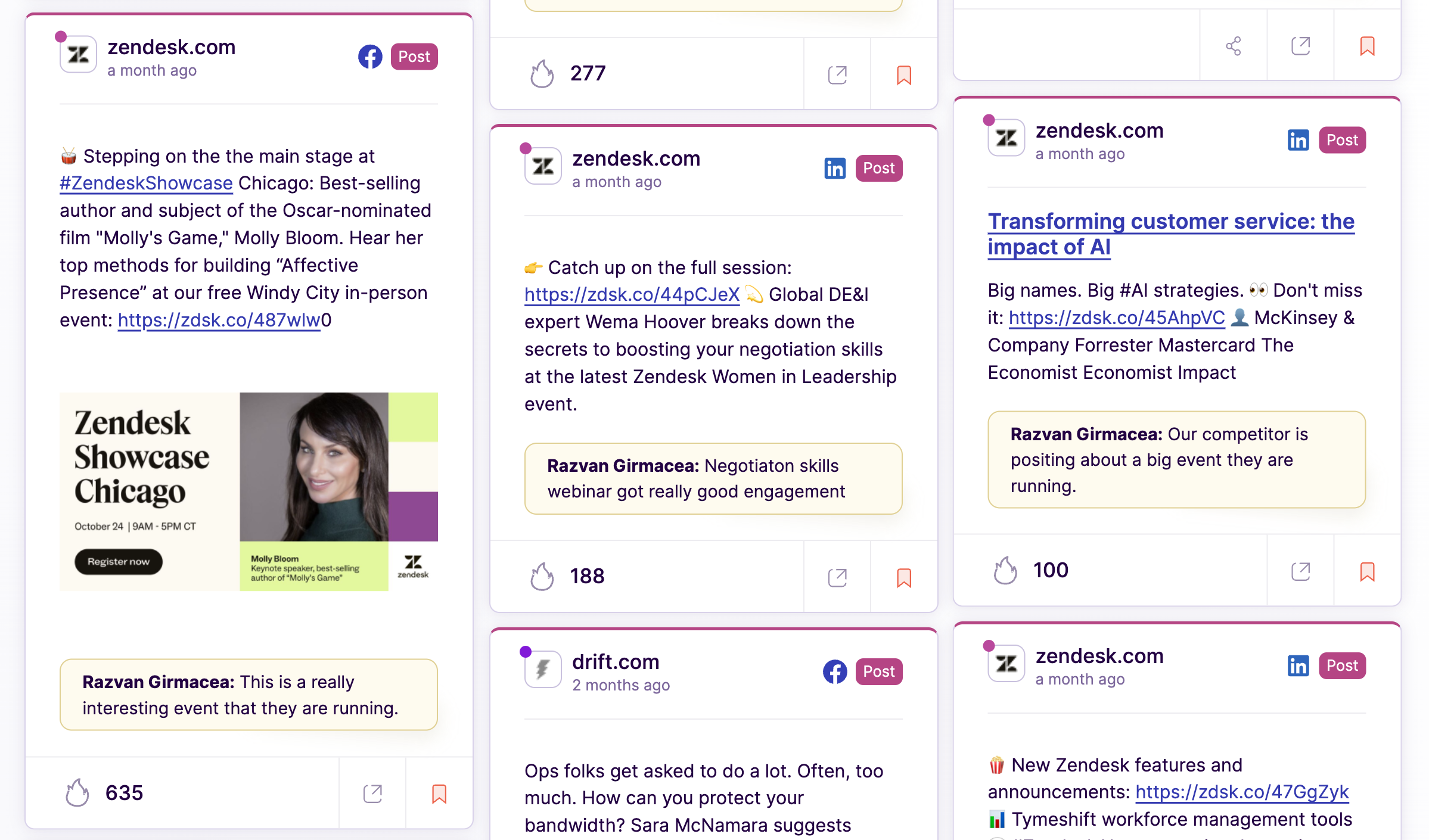
Step 6: Save insights and add notes to collect and explain the best competitor strategies
Finally, utilize one of our competitor analysis templates to compile all your findings into a comprehensive report. Share this with your team. It's important to add actionable tips at the end of the page.
Download our Free Competitor Analysis Template

I’ll be honest, doing competitive analysis can get overwhelming fast.
That’s why, we’ve put together a library of competitor analysis templates covering all the major processes you need to stay ahead without drowning in data.
Grab the Competitive Analysis Template Here
Need more? We also wrote a full breakdown of 15+ competitor analysis templates you can grab right here.
Competitive Analysis Techniques: Our Top 3 Picks
Most people think competitive analysis is all about spying on competitors and taking notes.
But that’s just the fastest way to waste time. If you don’t use the right techniques at the right time, you’ll end up wasting hours of “research” and nothing to show for it.
Here are three methods top brands actually use to track competitors efficiently without getting lost in the noise:
1. SWOT Analysis: The Big-Picture Breakdown
What is it?
A SWOT Analysis is a break down of a competitor’s Strengths, Weaknesses, Opportunities, and Threats.
When should you apply it?
- When entering a new market or launching a new product.
- When re-evaluating your positioning against competitors.
How is it done?
- Go through your competitors’ public reports, funding news, and team growth to understand their market position.
- Analyze customer sentiment – are people talking good about their product or complaining?
- Spot threats & opportunities – what gaps aren’t they filling that you can?

2. Competitor Benchmarking: Where Do You Stand?
What is it?
This technique compares your key performance indicators (KPIs) such as SEO rankings, ad spend, and social engagement against that of your competitors.
How often should you apply it?
- Monthly or quarterly: to keep track of how the competition is shifting.
- When you notice a competitor gaining traction and want to figure out why.
How is it done?
Instead of manually tracking a dozen competitors, use Competitors App to:
- Track SEO rankings & see who’s outranking you.
- Monitor competitor social media engagement.
- Get real-time insights on their marketing performance.

3. Customer Reviews Analysis: Find the Gaps in Their Business
What is it?
Customer reviews are one of the most underrated and often overlooked competitive analysis tools. They tell you exactly what customers love (or hate) about your competitors.
When should you use it?
- Ongoing: Customer sentiment changes fast, and you must keep up with it.
- When planning new product features, pricing changes, or messaging updates.
How to do it right?
With Competitors App, you can:
- Track competitor reviews across different platforms.
- Spot negative trends customers are complaining about.
- Find gaps competitors aren’t solving – and use them to your advantage.
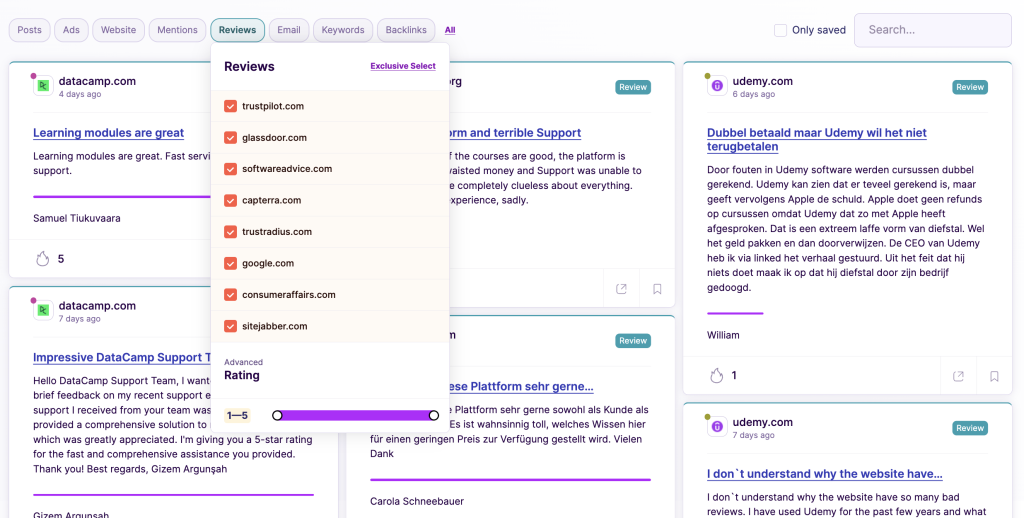
Apart from these techniques, there are multiple other methods like market segmentation analysis, pricing analysis, and feature comparison. To learn more about these and other techniques, check out our blog post, “15+ Techniques for Comprehensive Competitive Analysis.”
Choosing the right competitive analysis tool
Let’s be real. Competitive analysis is a waste of time if you don’t have the right tools.
You have 2 options, either spend hours trying to find the right insights manually, or you just let the right tools do the homework for you.
The right tools give you real data on what your competitors are doing and how you can catch up with them.
We’ve put together a full list of the best competitive analysis tools out there and how to choose from them in our dedicated guide on Competitive Analysis Tools. We’ve got you covered with all the right tools from SEO, PPC, Social Media and even customer review monitoring tools.
Digital Competitive Analysis
Checking out your competitors’ website isn’t enough to say you’ve done competitor analysis, You need to dig deep into how they’re actually getting traffic, engagement, and conversions.

Social Media Competitive Analysis
What platforms are they active on? How often do they post? How engaged is their audience? Are they leveraging influencers, partnerships, or viral content? Why it matters: If your competitor is dominating on TikTok or LinkedIn and you’re still focusing on Facebook, you’re already behind.
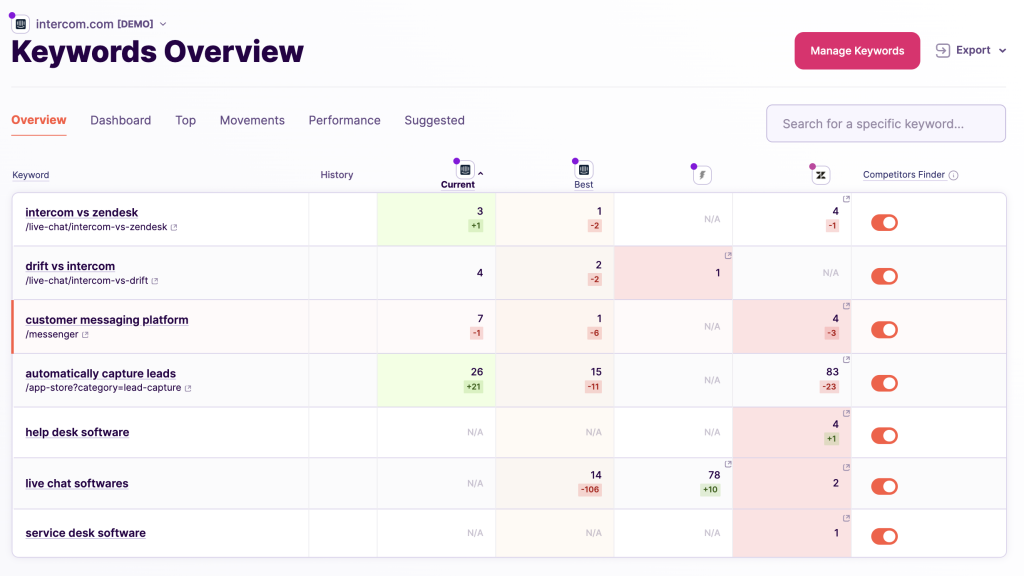
SEO Competitive Analysis
What keywords are they ranking for? Are they consistently publishing blog content? How strong are their backlinks? Why it matters: If a competitor outranks you for high-intent keywords, they’re stealing your potential customers before they even see your brand.
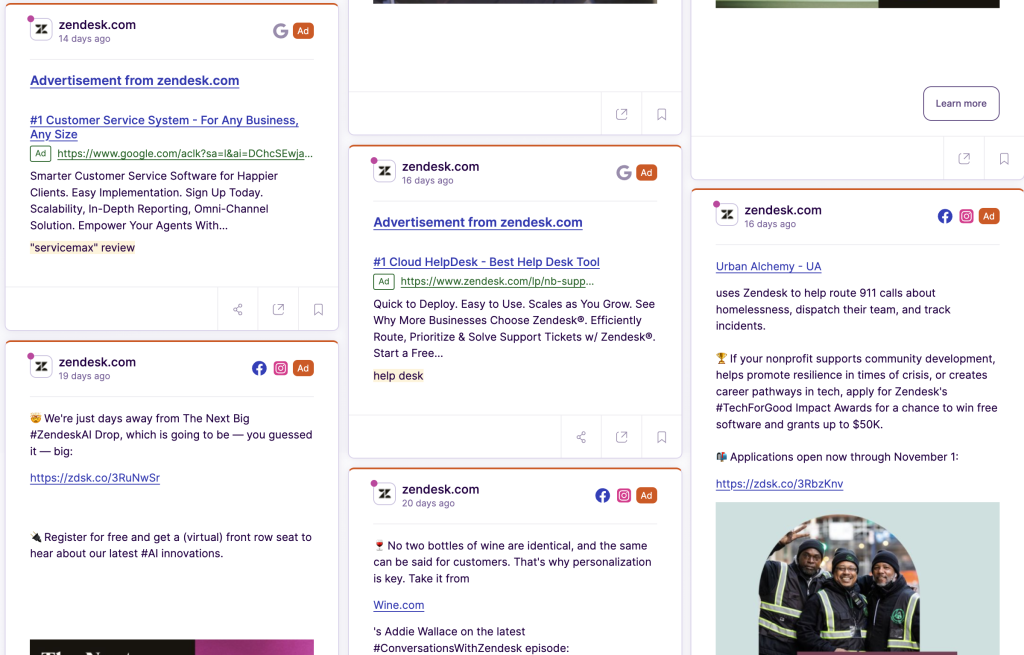
PPC Competitive Analysis
Are they running Google Ads, LinkedIn Ads, or Meta Ads? What keywords are they bidding on? What kind of messaging are they using in their ad copy? Why it matters: If a competitor is outbidding you on high-value keywords, they’re grabbing leads before they even reach your site.

Website Competitor Analysis
What’s their website speed and user experience like? Are they making major updates or A/B testing different layouts? Do they have a blog, case studies, or other high-value content? Why it matters: A slow, outdated website kills conversions. If competitors are constantly optimizing, you can’t afford to sit still.
Competitor Business Analysis Examples

Let’s say I was starting a digital marketing agency for local bakeries. I wouldn’t just launch blindly and hope for the best.
I’d try to figure out who my direct competitors are, how they’re getting clients, and how I can compete with them.
Here’s exactly how I’d do it:
Step 1: Find Out Who I’m Competing Against
First, I’d start with a super simple Google search for “digital marketing for local bakeries” and see who pops up.
The top organic results and paid ads, Those are my direct competitors.
They’re running ads? This means that they’re spending money to capture the same clients I want.
Step 2: Analyze My Competitors’ Online Presence
Once I have a list of competitors, I’d spend some time analysing their online presence.
- I’d check their website, services, and pricing. Are they offering something that I don’t offer?
- I’d read their customer testimonials to see what clients love (or hate).
- I’d use a tool like Competitors App to track their SEO rankings, keyword strategy, and social media engagement.
- I’d look at their ad copies. What messaging are they using to attract clients?
If they’re doing great in certain platforms or mediums, I’d take notes. If I see gaps, that’s my opportunity.
Step 3: Compare Their Strengths and Weaknesses to Mine
Now that I understood what my competitors were doing, I’d turn the focus back to my own business.
- Do they have better pricing? If yes, can I compete or offer something more valuable?
- Do they have more case studies or client success stories? If so, I’d need to start building mine.
- Are they missing key services that bakeries actually need? If yes, that’s where I’d position myself differently.
A simple SWOT analysis (Strengths, Weaknesses, Opportunities, Threats) helps make this analysis easier and clearer.
Step 4: Find the Gaps and Make a Move
- Are they only working with big bakery chains? Maybe I focus on small, independent bakeries instead.
- Are they offering generic marketing services? Maybe I position myself as “the only agency that specializes in bakery Instagram growth”.
- Are they ignoring local SEO? I’d make that my #1 selling point.
Why This Works
The sad reality is that most people get stuck in endless competitor research without actually turning it into something actionable.
But if you follow these steps, you’re not just “analysing” competitors or taking random notes – you’re actually figuring out how to outperform them.
Want more real-world competitive analysis examples? Check out our blog on Competitive Analysis Examples.
Drawbacks of Competitive Analysis
I learned this the hard way: competitive analysis can be a double-edged sword.
When done right, it gives you a serious advantage.
When done wrong, it can distract you, mislead you, and even slow you down.
Here are some of the biggest mistakes I’ve made and what I wish I knew earlier.
1. It Can Eat Up Your Time (If You Let It)
When I first started tracking competitors, I spent way too much time collecting data and not enough time actually using it. I’d go down rabbit holes, checking every little move a competitor made, thinking it would give me some secret edge.
Spoiler Alert: it didn’t.
The fix? Figure out what you can automate and focus only on insights that lead to actionable insights. Don’t waste lots of hours tracking competitors just to get that nice feeling of being “informed.”
2. You Can Get Too Obsessed With Competitors
I remember a time when I was so focused on what my competitors were doing, I started copying their every move. Instead of thinking about what made my brand different, I was trying to “keep up.”
Bad idea.
If you spend too much time watching competitors, you risk losing focus on your own customers. Competitive analysis should guide your strategy, not completely control it.
3. The Data Isn’t Always Right
A big mistake I made early on was treating every number I found as fact.
Most competitor data comes from public sources, third-party tools, and estimates. While these tools are great for direction, they’re never 100% accurate.
If you base your whole strategy on guesses and projections, you might end up chasing phantom trends.
Trust the data, but always verify with real customer insights.
4. You Might Only See What You Want to See
I’ve caught myself doing this: looking for data that supports what I already believe and ignoring anything that contradicts it.
This is a very common mistake and it stems from confirmation bias. This alone can ruin your entire strategy.
Spend as much time as you want learning about what makes your competitors successful but also keep an eye on their failures too!
You’ll learn just as much (if not more) from where they’re losing customers as from where they’re winning.
5. The Market Changes Faster Than You Think
One of the biggest lessons I’ve learned? What worked yesterday may not work tomorrow.
I’ve seen brands dominate a market one year and struggle the next because they didn’t adapt.
Competitive analysis isn’t something you do once and forget about. It needs to be updated regularly. Otherwise, you’ll be making decisions based on outdated insights.
1. What is the meaning of competitor analysis?
Competitor analysis is the process of identifying and evaluating the strengths, weaknesses, strategies, and market positions of businesses operating in the same industry or targeting the same audience. This analysis helps organizations understand their market dynamics, anticipate competitors’ moves, and refine their own strategies to gain a competitive advantage. It typically involves assessing key areas like pricing, product features, marketing tactics, and customer perceptions to make data-driven business decisions.
2. Why perform a competitive analysis?
Competitive analysis allows you to understand your market better, identify gaps in your strategy, and discover opportunities to outperform your competition.
3. How do you do competition analysis?
To perform a competition analysis, follow these steps:
- Identify Your Competitors: Categorize them as direct, indirect, or replacement competitors. Use industry reports, customer feedback, and tools like Google Alerts or Competitors App for insights.
- Gather Key Data: Collect information on competitors' products, pricing, marketing strategies, customer reviews, and market positioning.
- Analyze Their Strategies: Evaluate their strengths, weaknesses, opportunities, and threats (SWOT). Pay close attention to their content, advertising, and customer engagement efforts.
- Benchmark Your Business: Compare your performance against your competitors to identify gaps and opportunities for improvement.
- Document and Act: Save insights and develop actionable strategies based on the analysis to enhance your competitive positioning.
4. When is it time to do a competitive analysis?
There's no hard and fast rule, but it's generally good to conduct a competitive analysis at least once a year, or when you're considering a major business pivot.
5. Is competitive analysis the same as SWOT analysis?
No, SWOT analysis is a component of competitive analysis that focuses on your own company's Strengths, Weaknesses, Opportunities, and Threats. Competitive analysis is broader and includes evaluating your competitors as well.
6. How is competitive analysis performed?
Competitive analysis is performed by collecting data on your competitors and evaluating their strategies, strengths, and weaknesses. Tools like Competitors App can streamline this process.
7. What are the types of competitive analysis?
There are various types, including digital competitive analysis, product competitive analysis, and customer experience analysis, among others.
8. What are the objectives of competitive analysis?
The main objectives are to understand your competitors' strategies, identify market gaps, and find opportunities to gain a competitive edge.


